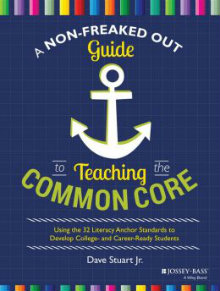A Calming Look at the ELA Anchor Standards
A Non-Freaked Out Guide to Teaching the Common Core: Using the 32 Literacy Anchor Standards to Develop College- and Career-Ready Students
By Dave Stuart, Jr.
(Jossey-Bass, 2014 – Learn more)

My English Language Arts colleagues could have used this book when the ELA Common Core State Standards were introduced a few years ago. With little training in what teaching the standards entailed, they were definitely freaking out.
Even now, after using the standards for a while, they are still overwhelmed by all the skills and knowledge they have to teach each year. A Non-Freaked Out Guide to Teaching the Common Core will make the standards of the CCSS more accessible to ELA teachers as well as ESL, content, and special education teachers who also use the ELA Common Core standards.

In fact, A Non-Freaked Out Guide to Teaching the Common Core thoroughly answers a question I’d been wondering about for a while; namely, why argumentative writing is listed first in the writing standards. This book is written in an informal style, which makes the concepts less impenetrable and more comprehensible, and at only 172 pages, it is a quick and easy read.
A helpful introduction
The author opens by providing background information about the CCSS in the Introduction and Part I. Stuart, founder of the Teaching the Core blog, defines what the anchor standards are—general expectations of what a student should be able to do—and differentiates it from the grade-level specific standards.
The rest of the book is divided into four sections: reading, writing, speaking and listening, and language (i.e. grammar). A conclusion, an appendix that presents the anchor standards on a two-page spread, along with a bibliography and an index, complete A Non-Freaked Out Guide to Teaching the Common Core.
A close look at every ELA anchor standard
The heart of the book consists of the four language-focused sections, in which every anchor standard is broken down into its component parts. A one-page description of how the anchor standards are organized opens each section; this is very helpful because it gives readers an overview of what that section’s anchor standards are all about.
Stuart then proceeds to explain each particular anchor standard. The format is the same for all four sections: The anchor standard is highlighted in a box, and the key words and phrases are broken down and explained. Then Stuart ends with a short explanation of why it is important that college- and career-ready students be familiar with the skills delineated in that anchor standard.
Subtitles are used when Stuart parses each anchor standard and that makes the information more easily digestible. He also includes anecdotes from his teaching practice and sometimes includes suggestions for teaching an anchor standard. I would have liked to see more such teaching suggestions but that would have made this a different book, and Stuart keeps the focus on what the anchor standards mean, not on how to teach them.
A Non-Freaked Out Guide to Teaching the Common Core became more helpful as I read through it. I felt Stuart started providing more useful information about halfway through his explanation of the reading anchor standards. I found the following aspects were especially informative when he was explaining these standards:
* R.CCR.6: Pages 44 – 46, about point of view
* W.CCR.5: Pages 88 – 90, questions to ask students during pre-writing and revising
* W.CCR.7: Page 101, about the difference between summarizing research and writing a paper based on research
* SL.CCR.1: Page 117, ideas for practicing and evaluation speaking
A concern about R.CCR.10
I did, however, take issue with Stuart’s embrace of R.CCR.10, about getting all students to read on grade level. He states, “In other words, even if seventh grader Susan reads at a third-grade level, she has frequent opportunities throughout the school year and across the content areas to be taught how to read texts that are appropriately complex for the seventh grade.” (P. 58)
This rather simplistic and optimistic assertion does not take into account the different learning needs and abilities of English Language Learners or special education students. Stuart would have presented a better argument for this anchor standard if he had not merely stated, “Thankfully, the CCSS don’t dictate how we’re to accomplish the staircase of complexity. This leaves a lot of flexibility within which we, as teachers, can practice the entrepreneurship and collaboration that should be central to our profession.”
If, as he did for some other anchor standards, he had offered some actual ideas on how teachers could get their below grade-level-reading students up to grade level, Stuart would have a stronger case for the importance of this anchor standard.
A useful supplement
Overall though, A Non-Freaked Out Guide to Teaching the Common Core is a useful supplement to the primary CCSS document. Although high school teachers will probably find the book most useful, since the anecdotes Stuart provides come from his high school teaching experience, and middle school and elementary teachers may not be familiar with the texts he cites, all teachers will benefit from his analysis of each individual anchor standard. As Stuart writes in the Introduction, “In this book, we will simply read the anchor standards together, unpacking what they say…” (P. 2) He achieves his objective.
Susan Schwartz was an English as a Foreign Language teacher and teacher trainer at universities in China and Indonesia before spending 16 years at Marsh Grammar School in Methuen, Massachusetts, where she most enjoyed teaching Social Studies to ELL middle schoolers and her favorite co-teaching experience was with a 6th grade ELA class. Susan traveled to India on a Fulbright-Hays Seminars Abroad program in 2007 and received an ING Unsung Heroes Award in 2010.































Thank you for this honest review. We can’t deny that many many kids do not read on grade level, and we need strategies to get them there. A lack of reading ability is one of the main reasons kids don’t reach the standards.